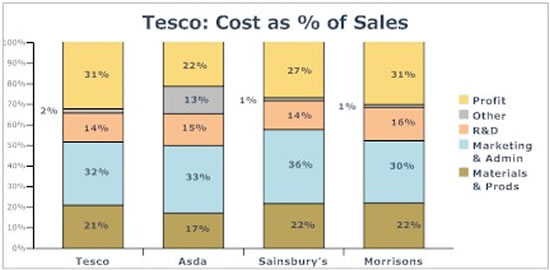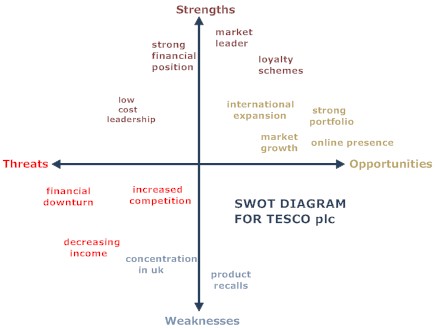 Section
Navigation
Section
Navigation
9. Learning from Others
9.1
Introduction: Grouping by Business Models
:Cautionary Tales
9.2
A Start
9.3 Coins International
9.4 Fine Art Ceramics
9.5 Halberd Engineering
9.6
Ipswich Seeds
9.7 Seascape e-Art
9.8 Whisky Galore
:Case
Studies
9.9 Amazon
9.10
Andhra Pradesh
9.11 Apple iPod
9.12 Aurora Health Care
9.13
Cisco
9.14 Commerce Bancorp
9.15 Craigslist
9.16
Dell
9.17 Early Dotcom
Failures
9.18 Easy Diagnosis
9.19 eBay
9.20
Eneco
9.21 Fiat
9.22
GlaxoSmithKline
9.23 Google ads
9.24 Google services
9.25
Intel
9.26 Liquidation
9.27
Lotus
9.28 Lulu
9.29
Netflix
9.30 Nespresso
9.31
Netscape
9.32 Nitendo wii
9.33 Open Table
9.34
PayPal
9.35 Procter & Gamble
9.36 SIS Datenverarbeitung
9.37 Skype
9.38
Tesco
9.39 Twitter
9.40
Wal-mart
9.41 Zappos
9.42
Zipcar
 9.38
Tesco plc
9.38
Tesco plc
Tesco was founded in 1919 and launched its first store in Edgware, London,
UK in 1929. Today, Tesco is the world's third-largest retailer (after Wal-mart and
Carrefour) {10} with 2012 figures as follows: revenues £72.0 billion, of which
£3.8 billion was trading profit. Revenues were 66% UK, 15% Europe, 17% Asia
& USA, and 2% Tesco Bank. The company employed 520,000 staff in 14 countries and
operated 6,351 stores. The UK Tesco Bank has 6.5 million customer accounts, and generated
£168 million in profits. Tesco Mobile, a telecom business, had 3.2 million customers.
{13} {14} Though still still essentially UK-based, Tesco has diversified geographically and into widely-separated market sectors: retailing books, clothing, electronics, furniture, petrol and software, financial services, telecom and Internet services, DVD rental, and music downloads.{10}
Tesco's entry into the enormous but difficult US market with 'Fresh & Easy' convenience stores is being watched with some skepticism. {4} {6} Unlike operations elsewhere, the US division posted a £186 million loss in 2010-11. Tesco did indeed withdraw subsequently from the US market with a loss of £1 billion, and took a further £804 million hit on the UK property market in 2012. Business in 2013 is expected to focus more on the UK. {20}
Competition
Tesco is an aggressive company benefiting from Internet technologies, as indeed are its main UK rivals. {9} Sainsbury's and Morrisons cater for more affluent customers, and Asda focuses on the more cost-conscious. Market share as of 2008 was: Tesco 30.5%, Asda 16.9%, Sainsbury's 16.3, and Morrisons 12.3%.{10} A cost breakdown is given below. {9}

Strategy
Tesco has built its fortune on two business elements: an unrelenting drive to provide value to customers, and continued investment in the latest technologies — today customer relationship management, Internet and mobile phone shopping, and supply chain management (probably a private industrial network, though details are not available).
Back in 1995, however, Tesco was losing market share, causing Terry Leahy, the new CMO, to reexamine its market position and propose a three-pronged solution: {11}
1. Stop copying Sainsbury's and
develop its own strategy.
2. Listen to customers throughout the company, at every
level.
3. Offer goods and services as the customer valued, not what Tesco could
do (i.e. adopt an outside-in strategy).
Customer Relationship Management
Tesco went to extraordinary lengths to understand its customers and add value to their lives.
1.
Marketing was aimed at sensible, middle-class families, from its slogan 'Every little
helps' to its no-frills website. {11} {14}
2. A loyalty card ('Clubcard') was
introduced in 1995, and data subsequently fed into Customer Management Systems. {10}
3. American preferences were studied by embedding staff with US families prior to
launching its USA operation in 2007. {11}
Internet Technology
Tesco has been particularly forward-looking. It was one of the first to: {10}
1. Use
self-service tills and cameras to reduce queues. {10}
2. Introduce Internet shopping
in the late 1990s.
3. Offer Internet shopping (1994), and a robust home shopping
service (1996).
4. Use CRM and supply chain management, extending these when
entering new markets. {4}
5. Use private industrial networks. {4}
Outlook: Pestel Analysis
A Pestel analysis identifies the forces with most impact on Tesco performance.{9}
Political
Tesco benefited from access to the world's most profitable market of 1.3 billion people, notably by:
1.
Britains' joining the European Union, and the inclusion of 10 more countries in 2004.
2. China's entry into the WTO.
Economic
The continuing recession has made supermarket customers:
1. More cautious and cost-conscious.
2.
More inclined to eat in that go out to restaurants.
Social
As the UK's population changes (especially ages), customers:
1. Tend to eat (and therefore
buy) less food.
2. Have become more health conscious, met by Tesco's increased
stocking of organic foods.
3. Have been retained by Tesco loyalty programs.
Technological
Tesco were early leaders in Internet shopping, supply chain management and customer relationship management. These continue to be vital today with:
1. Customer loyalty cards
and Internet shopping records providing CRM information.
2. Growth of Internet
use and broadband access fueling growth in Tesco online shopping.
3. Mobile phone
shopping, introduced with Cortexica Vision Systems for Tesco Wines, etc.
4. Supply
chain management: rumored to be the world's best, still being extended. {4}
Environmental
Tesco has responded to Government environmental initiatives by:
1.
Encouraging reuse of plastic bags.
2. Rewarding bagless deliveries with Tesco's
green Clubcard points.
3. Providing practical advice of environmental issues.
4. Adding carbon footprint data to its products.
Legal
1. European
VAT increases will affect nonfood sectors like clothing.
2. Increase in the UK's
minimum wage will increase Tesco operating costs.
Outlook: Swot Analysis

The SWOT {9} analysis regards the UK concentration of business as a weakness, though this is a market Tesco knows well, and which saw further expansion in 2011. {13}
Outlook: Value Chain Analysis
As defined by Lynch (2006), {19} the value chain is the value added at each link in a company's key activities. For Tesco, the values are: {9}
Inbound Logistics: 20%
1. Use of leading market position
and economies of scale to achieve low costs from its suppliers.
2. Constant upgrading
of their ordering system, approved vendor lists, and in-store processes.
Operations Management: 30%
1. Supply chain management: £76 million investment brought £550 million in increased profitability during 2009 alone.
Inbound Logistics: 20%
1. Use of leading market position and economies of scale to
achieve low costs from its suppliers.
2. Constant upgrading of their ordering
system, approved vendor lists, and in-store processes.
Operations Management: 30%
 Questions
Questions
1. Give a brief description of Tesco plc. How does it compare to other leading
supermarket chains?
2. What are the two business elements on which Tesco has
built its fortune? Provide some details.
3. Provide a Pestel analysis of Tesco
plc. What does it show?
4. Give a SWOT analysis of Tesco plc.
5. What does
a value chain analysis applied to Tesco show?
6. How has Tesco plc fared outside
the UK, and why?
 Sources
and Further Reading
Sources
and Further Reading
1. Tesco reinvents the 7-Eleven by
Matthew Boyle and Michael V. Copeland. Fortune.
November 2007.
2. 'Big-Headed' Tesco May Start A Retail Revolution by
Sarah Mahoney. Marketing
Daily. October 2007.
3. Tesco plc by David E. Bell. Harvard Business
School Case 9-503-036. 2006.
4. Tesco enters retail with cash and carry.
Financial
Express. August 2008.
5. Tesco's American Gamble by James Hall.
The
Telegraph. June 2010.
6. Why is Tesco struggling in the US? by
Tom Geoghegan. BBC
News. May 2011.
7. Tesco — The brand experience is everything.
Branding
Asia. Excerpt from Hi-Tech Hi-Touch Branding by Paul Temporal and K.C.
Lee. John Wiley & Sons. January 2001.
8. Tesco. SupplyChainAnalysis.
Notes on various aspects of Tesco systems.
9. SWOT, PESTEL, Porter's Five Forces
and Value Chain Analysis of Tesco. Ivory
Research. Detailed study with references.
10. Tesco. Wikipedia.
Extensive entry.
11. Strategy from the Outside In by George S. Day and
Christine Moorman. McGraw Hill. 2010. Chapters 2 and 10.
12. Ecommerce 2010
by Kenneth C. Laudon and Carol Guercio Traver. Pearson. 2010. Section 2.13-16.
13. Tesco Annual Report 2012. Tesco.
14. Tesco plc. Tesco.
Company homesite.
15. Corporate Strategy: 4th Edition by R. Lynch. Pearson.
2006.
16. Tesco to exit Japan after eight-year struggle. Guardian.
August 2011.
17. Tesco aims to expand online model overseas by Elizabeth
Rigby and Andrea Felsted. FT.
September 2010.
18. Tesco Needs U.K. Boost by Kathy Gordon. WSJ.
June 2011.
19. What is value chain analysis? by Kedar Karki. Scrbd.
June 2008.
20. A bad year comes to an end for Tesco
by Garry White. Daily
Telegraph. April 2013.